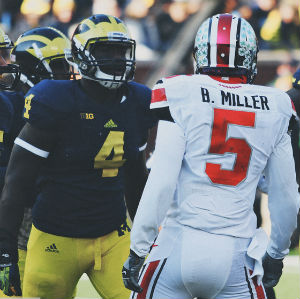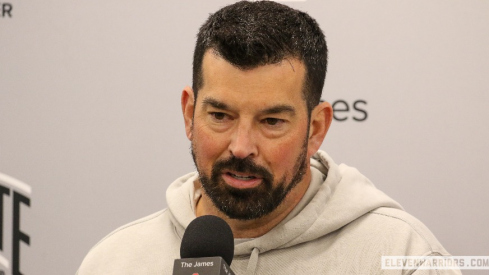Ohio State and Michigan have been meeting in the final week of the regular season for a long time.
According to the 2014 Ohio State Media Guide, the Buckeyes first played Michigan on Oct. 16, 1897—the team’s third game of the season. The Wolverines drifted around the schedule back in those early years. October. November. Sometimes not at all. Didn’t matter much then. Results were often undesirable anyway.
Not many know that Kenyon was the first opponent to serve as any kind of traditional season ender in the OSU program’s fledgling years. It wasn’t until 1935 that Michigan appeared last on Ohio State’s schedule. But even so, there has been an exceptions since—namely 1942, when the Buckeyes finished against the Iowa Seahawks.
Today, the landscape of Ohio State football looks very different than it has for most of the 125 years of its existence. There are 14 teams in the school’s conference, divided into two seven-team divisions. The league has a postseason championship game. And of course we begin the four-team College Football Playoffs soon (but not soon enough…please hurry, Aug. 30!).
Does the sea change in the importance and length of the college football season serve as a force majeure to sever the longstanding tradition of facing the bitter and hated rivals from That State Up North on the final Saturday of the regular season?
Before you tar and feather me for the mere suggestion, the idea bears a little consideration.
Why The Game shouldn’t move
Traditions make college football special. Ohio State and Michigan have met in the season finale with only one exception for 79 years. That’s a lot of history. Who are we to decide to sweep all of that away?
The Game is arguably (except to us) not only college football’s greatest rivalry, but also the best rivalry in all of sports. It falls at a time of the year around which all of the intense battles take place—the Iron Bowl, Florida vs. Florida State, and the like. Might as well let the biggest of all the traditional clashes stay where it is and save the best for last.
Historically, The Game has largely decided at least a share of the Big Ten title. Keeping it at the end ramps up the intensity, not only for the final game, but also for all of the ones leading up to it. Ohio State and Michigan typically know that they can’t make a mistake during the season and if they do, they have only one opportunity to make up for it at the end of the year.
The matchup only decides one division now, but the stakes are still high. The Game can help settle the B1G East Division. What the winner does afterward is up to them.
Why The Game should move

The intensity of the Ohio State-Michigan rivalry is a year in the making. It starts at the conclusion of the previous year’s game. The losing team stews and plots revenge while the winners enjoy their bragging rights. The season comes to a crescendo with The Game.
But might that not be a problem? There are conference goals beyond beating Michigan now. Can players reasonably be expected to reach maximum intensity, battle insanely against their most bitter foes, take the prize, and then somehow regain that level of passion again just a week later at a neutral site? Did it penalize Ohio State last season to experience a slugfest with their enemies from the north and hang on for an emotional win, while Michigan State cruised to a 14-3 win over Minnesota?
Maybe.
In 2006, when No. 1 Ohio State overcame No. 2 Michigan, I wondered how Jim Tressel would get his team to that same level of fury against an unfamiliar foe they were favored to beat. I have no idea how much, if at all, the mindset of the team was affected by overcoming what seemed to be their biggest obstacle to the championship.
I feel like it had to play at least a small part in some players’ minds. It’s possible that the Buckeyes and Wolverines having to get emotionally up for The Game and then immediately follow that with a conference championship game is a benefit to all other Big Ten teams.
Then there’s the spectacle of the game.
The only way to make the atmosphere of The Game even more insane is to hold it at night. There’s no way the two schools or the conference will go for it at the end of November. They’ll point to the weather and talk about how it can be bitterly cold and a safety issue. It’s no more a safety issue than playing at noon at the start of September, but they’ll use it as an excuse anyway.
I can’t be alone in wanting to see the spectacle of The Game at night. We got a little taste of it in 2006 with a contest that finished after sunset, under the lights, and it was amazing. Holding it earlier in the year would allow an 8:00 kickoff and the unbridled insanity of a 100,000+ crowd in full song, with a day’s worth of pent-up emotions spilling out and washing over the stadium. It would be incredible.
Of the reasons to move it, I think the intensity factor is the one that bears the most consideration. It will be interesting to monitor Ohio State and Michigan as they move forward and try to win league titles, to see if they sustain any hangover the following week in the B1G title game. I felt like Ohio State started the game with one last year against Sparty.
Smarter people than me, who draw much larger salaries than I do, will have to weigh these factors and decide whether moving The Game is something that could or should happen. I have a feeling both fan bases would rather leave the tradition alone. As evidence, some people still want noon kickoffs for The Game. As the kids say, SMH.


